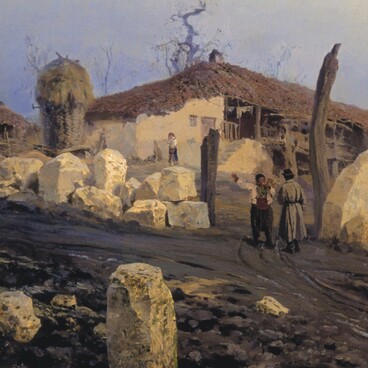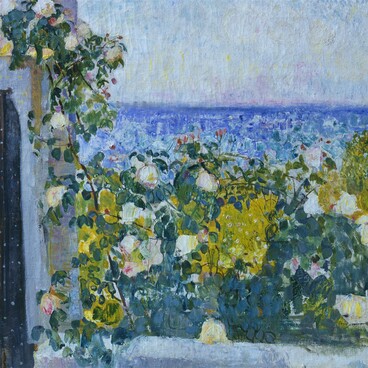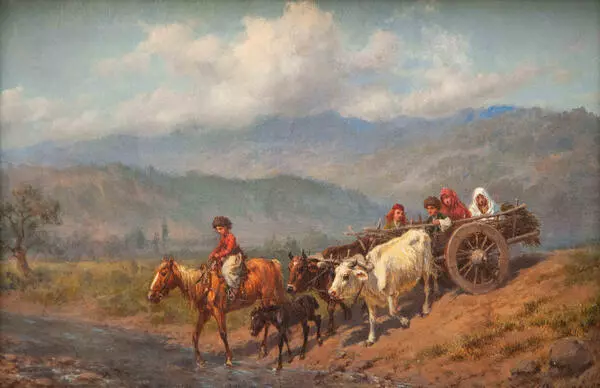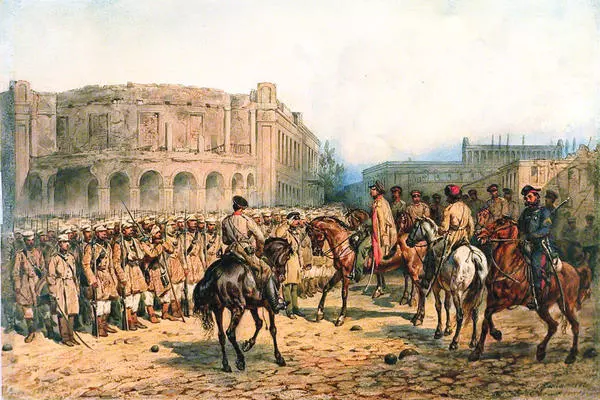Konstantin Filippov became known as a battle painter who created an artistic chronicle of Sevastopol defense during the Crimean War.
In 1850, Filippov entered the Imperial Academy of Arts, where until 1858 he studied under the guidance of Professor Bogdan Willewalde. At the Academy, he received a minor and major silver medals, as well as a minor gold medal for the work ‘Cossacks, Fighting off the French Attack on a Supply Carriage in the Campaign of 1812’.
The artist was sent to the front line to paint episodes of the Crimean War. In 1858, Filippov was awarded a major gold medal for the painting ‘The Military Road between Simferopol and Sevastopol during the Crimean War of 1855’.
For a year, the artist lived in Warsaw, where he painted battle pictures commissioned by the governor of the Kingdom of Poland, Mikhail Gorchakov. At that time, he received a pension from the Saint Petersburg Academy of Arts and went on a trip abroad.
Filippov was a real front-line artist. He took part in the defense of Sevastopol and was awarded the medal of the same name ‘For the Defense of Sevastopol’. In the 1870s, he served as a war correspondent for the Niva magazine in the Transcaucasus. Filippov spent the last years of his life on the southern coast of Crimea.
For a large-scale battle canvas ‘The Escape of the Bulgarians from the Danube after the Retreat of Russian Troops from Silistria’, displayed at the exhibition, Filippov received the title of academician in 1865. Filippov painted sketches for this painting during the war. This work became one of the first historical paintings, which was devoted to modern military events and not to subjects from the past. When working on the painting, Filippov paid great attention to the realism and reliability of the details.
On the canvas, the artist depicted one of the episodes of the Crimean War, when the carefully prepared assault on the city of Silistria, besieged by Russian troops, was unexpectedly canceled. The local population, fearing the reprisals of the Turks, left the area, many Bulgarians fled to Russia.
In 1850, Filippov entered the Imperial Academy of Arts, where until 1858 he studied under the guidance of Professor Bogdan Willewalde. At the Academy, he received a minor and major silver medals, as well as a minor gold medal for the work ‘Cossacks, Fighting off the French Attack on a Supply Carriage in the Campaign of 1812’.
The artist was sent to the front line to paint episodes of the Crimean War. In 1858, Filippov was awarded a major gold medal for the painting ‘The Military Road between Simferopol and Sevastopol during the Crimean War of 1855’.
For a year, the artist lived in Warsaw, where he painted battle pictures commissioned by the governor of the Kingdom of Poland, Mikhail Gorchakov. At that time, he received a pension from the Saint Petersburg Academy of Arts and went on a trip abroad.
At first, Filippov lived in Rome, where he created the paintings ‘Italian Smithy’ and ‘Donkey Races in Tivoli’, and then in Paris. In 1863, he returned to Russia and soon set off on a new journey — to the Caucasus.
Filippov was a real front-line artist. He took part in the defense of Sevastopol and was awarded the medal of the same name ‘For the Defense of Sevastopol’. In the 1870s, he served as a war correspondent for the Niva magazine in the Transcaucasus. Filippov spent the last years of his life on the southern coast of Crimea.
For a large-scale battle canvas ‘The Escape of the Bulgarians from the Danube after the Retreat of Russian Troops from Silistria’, displayed at the exhibition, Filippov received the title of academician in 1865. Filippov painted sketches for this painting during the war. This work became one of the first historical paintings, which was devoted to modern military events and not to subjects from the past. When working on the painting, Filippov paid great attention to the realism and reliability of the details.
On the canvas, the artist depicted one of the episodes of the Crimean War, when the carefully prepared assault on the city of Silistria, besieged by Russian troops, was unexpectedly canceled. The local population, fearing the reprisals of the Turks, left the area, many Bulgarians fled to Russia.





